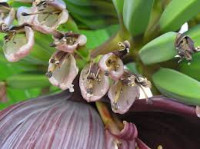Possible Potential Features of Phytoestrogens of Ambones Banana Blossom (Musa Acuminata Colla) as Nutraceuticals for Menopausal Vaginal Elasticity: An In Silico Study
Main Article Content
Abstract
Menopause is the period when the reproductive system stops producing estrogen and progesterone . This condition can cause various changes, including vaginal atrophy. Structural changes can occur because cytoskeletal proteins (actin) and junction cells (claudin-1) that regulate permeability undergo changes that cause thinning of the epithelium in the vagina which will lead to reduced vaginal elasticity. This study aimed to predict the activity of anthocyanin and genistein compounds with claudin-1 and Actin receptors in silico. This research was conducted using Autodock Vina software supported by the Vega ZZ, Pymol, and BIOVIA Discovery Studio programs to create visual profiles of Claudin-1 and Actin ligand proteins used as comparisons with Anthocyanin and Genistein test compounds, as well as pharmacokinetic predictions using pkCSM. The results of the post-docking analysis in the form of binding affinity for amino acid interactions and pharmacokinetics using anthocyanin and genistein compounds showed the largest binding affinity for Anthocyanin compounds with a Gbinding score of -6.81 kcal / mol (72.60%) close to estrogen's Gbinding score of -9.33 kcal/mol. The RMSD value of claudin-1 was 1.43Ã. This means that the claudin-1 protein has the right interaction between the original ligand and the test ligand. The results of the study have the potential to recommend nutraceuticals for drug discovery using natural ingredients containing anthocyanin and genistein compounds which can overcome complaints of vaginal elasticity in menopause. Further research can be donein vitro andin vivo to investigate these compounds clinically.
Downloads
Article Details

This work is licensed under a Creative Commons Attribution-NonCommercial-NoDerivatives 4.0 International License.
References
Talaulikar V. Menopause transition: Physiology and symptoms. Best Pract Res Clin Obstet Gynaecol. 2022;81(5):3–7.
Marino JM. Genitourinary Syndrome of Menopause. J Midwifery Women’s Heal. 2021;1(11):1-11.
Wańczyk-Baszak J, Woźniak S, Milejski B, Paszkowski T. Genitourinary syndrome of menopause treatment using lasers and temperature-controlled radiofrequency. Prz Menopauzalny. 2018;17(4):180-184.
Cagnacci A, Venier M. The controversial history of hormone replacement therapy. Med. 2019;55(602):1-11.
Mehta J, Kling JM, Manson JAE. Risks, Benefits, and Treatment Modalities of Menopausal Hormone Therapy: Current Concepts. Front Endocrinol (Lausanne). 2021;12(564781):1-14.
Canivenc-Lavier MC, Bennetau-Pelissero C. Phytoestrogens and Health Effects. Nutrients. 2023;15(317):1–44.
Panche AN, Diwan AD, Chandra SR. Flavonoids: An overview. J Nutr Sci. 2016;5(47):1–15.
Nanashima N, Horie K, Maeda H. Phytoestrogenic activity of blackcurrant anthocyanins is partially mediated through estrogen receptor beta. Molecules. 2018;23(74):1–11.
Kiyama R. Estrogenic flavonoids and their molecular mechanisms of action. J Nutr Biochem. 2023;114(109250):1–50.
Fithri AN, Yueniwati Y, Arsana IW, Khotimah H, Nurwidyaningtyas W. The Potential Health Benefit of Cowpea Estrogen-like Activity to Restore Vaginal Epithelial Cells Thinning Due to Menopausal Syndrome. Trop J Nat Prod Res. 2024;8(3):6624-6630.
Chiang SH, Yang KM, Lai YC, Chen CW. Evaluation of the in vitro biological activities of Banana flower and bract extracts and their bioactive compounds. Int J Food Prop. 2021;24(1):1–16.
Thagunna B, Kandel K. Banana Blossom: Nutritional Value, Health Benefits and It’s Utilization. Rev Food Agric ( RFNA ). 2023;4(2):62-66.
Musbahi E, Kamp E, Ashraf M, DeGiovanni C. Menopause, skin and common dermatosis. Part 3: genital disorders. Clin Exp Dermatol. 2022;47(12):2123-2129.
Garcia MA, Nelson WJ, Chavez N. Cell–Cell Junctions Organize Structural and Signaling Networks. Cold Spring Harb Perspect Biol. 2018;10(4):1–27.
Otani T, Furuse M. Tight Junction Structure and Function Revisited. Trends Cell Biol. 2020;30(10):805-817.
Kyung, Lee HS, Ahn K, Park K. Estrogen Modulates Expression of Tight Junction Proteins in Rat Vagina. Biomed Res Int. 2016;(2016):1–6.
Carpio LE, Sanz Y, Gozalbes R, Barigye SJ. Computational strategies for the discovery of biological functions of health foods, nutraceuticals and cosmeceuticals: a review. Mol Divers. 2021;25(3):1425-1438.
Rohman MS, Sulistomo HW, Kusumastuty I, Nugroho DA, Nugraheni NIP. In Silico Discovery of Green Tea and Green Coffee Bioactive Compounds Against. Trop J Nat Prod Res. 2024;8(3):6594-6603.
Asiamah I, Obiri SA, Tamekloe W, Armah FA, Borquaye LS. Applications of molecular docking in natural products-based drug discovery. Sci African. 2023;20(8):1–8.
Sadybekov A V., Katritch V. Computational approaches streamlining drug discovery. Nature. 2023;616(7958):673-685.
Yuliantini A, Ocktavyanie S, Febrina E, Asnawi A. Virtual Screening Using a Ligand-based Pharmacophore Model from Ashitaba (Angelica keiskei K.) Isolates and Molecular Docking to Obtained New Candidates as α-Glucosidase Inhibitors. Trop J Nat Prod Res. 2024;8(1):5811-5819.
Hosseini M, Chen W, Xiao D, Wang C. Computational molecular docking and virtual screening revealed promising SARS-CoV-2 drugs. Precis Clin Med. 2021;4(1):1–16.
Maruyama Y, Igarashi R, Ushiku Y, Mitsutake A. Analysis of Protein Folding Simulation with Moving Root Mean Square Deviation. J Chem Inf Model. 2023;63(5):1529-1541.
Karami TK, Hailu S, Feng S, Graham R, Gukasyan HJ. Eyes on Lipinski’s Rule of Five: A New “Rule of Thumb” for Physicochemical Design Space of Ophthalmic Drugs. J Ocul Pharmacol Ther. 2022;38(1):43–55.
Eberhardt J, Santos-Martins D, Tillack AF, Forli S. AutoDock Vina 1.2.0: New Docking Methods, Expanded Force Field, and Python Bindings. J Chem Inf Model. 2021;61(8):3891-3898.
Lecomte S, Demay F, Ferri F, Pakdel F. Phytochemicals Targeting Estrogen Receptors : Beneficial Rather Than Adverse Effects. Mol Sci. 2017;18(1381):1–19.
Inayati I, Arifin NH, Febriansah R, Indarto D, Suryawati B, Hartono H. Biofilm-forming Klebsiella pneumoniae : An In Silico Study. Trop J Nat Prod Res. 2023;7(10):4249-4255.
Makeneni S, David F. Thieker and RJW. Applying Pose Clustering and MD Simulations To Eliminate False Positives in Molecular Docking. J Chem Inf Model. 2018;58(3):605-614.
Chen X, Li H, Tian L, Li Q, Luo J, Zhang Y. Analysis of the Physicochemical Properties of Acaricides Based on Lipinski’s Rule of Five. J Comput Biol. 2020;27(9):1-10.
Kralj S, Jukič M, Bren U. Molecular Filters in Medicinal Chemistry. Encyclopedia. 2023;3(2):501-511.
Kadry H, Noorani B, Cucullo L. A blood–brain barrier overview on structure, function, impairment, and biomarkers of integrity. Fluids Barriers CNS. 2020;17(69):1–24.
Peter Guengerich F. Cytochrome P450 research and The Journal of Biological Chemistry. J Biol Chem. 2019;294(5):1671-1680.
Honma M. An assessment of mutagenicity of chemical substances by (quantitative) structure-activity relationship. Genes Environ. 2020;42(23):1–13.


